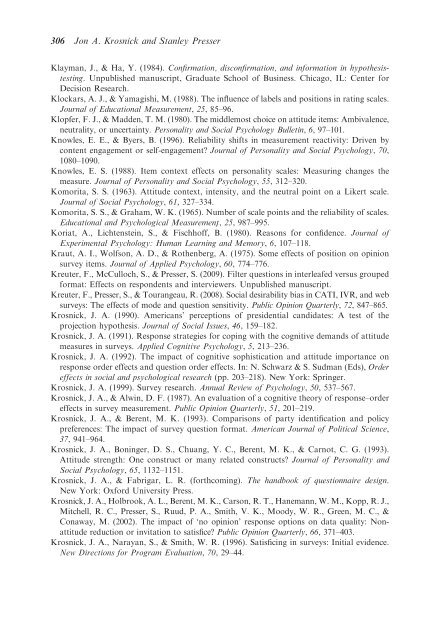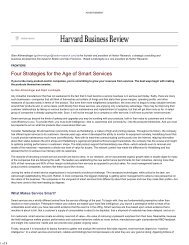Question and Questionnaire Design - Stanford University
Question and Questionnaire Design - Stanford University
Question and Questionnaire Design - Stanford University
Create successful ePaper yourself
Turn your PDF publications into a flip-book with our unique Google optimized e-Paper software.
306 Jon A. Krosnick <strong>and</strong> Stanley PresserKlayman, J., & Ha, Y. (1984). Confirmation, disconfirmation, <strong>and</strong> information in hypothesistesting.Unpublished manuscript, Graduate School of Business. Chicago, IL: Center forDecision Research.Klockars, A. J., & Yamagishi, M. (1988). The influence of labels <strong>and</strong> positions in rating scales.Journal of Educational Measurement, 25, 85–96.Klopfer, F. J., & Madden, T. M. (1980). The middlemost choice on attitude items: Ambivalence,neutrality, or uncertainty. Personality <strong>and</strong> Social Psychology Bulletin, 6, 97–101.Knowles, E. E., & Byers, B. (1996). Reliability shifts in measurement reactivity: Driven bycontent engagement or self-engagement? Journal of Personality <strong>and</strong> Social Psychology, 70,1080–1090.Knowles, E. S. (1988). Item context effects on personality scales: Measuring changes themeasure. Journal of Personality <strong>and</strong> Social Psychology, 55, 312–320.Komorita, S. S. (1963). Attitude context, intensity, <strong>and</strong> the neutral point on a Likert scale.Journal of Social Psychology, 61, 327–334.Komorita, S. S., & Graham, W. K. (1965). Number of scale points <strong>and</strong> the reliability of scales.Educational <strong>and</strong> Psychological Measurement-, 25, 987–995.Koriat, A., Lichtenstein, S., & Fischhoff, B. (1980). Reasons for confidence. Journal ofExperimental Psychology: Human Learning <strong>and</strong> Memory, 6, 107–118.Kraut, A. I., Wolfson, A. D., & Rothenberg, A. (1975). Some effects of position on opinionsurvey items. Journal of Applied Psychology, 60, 774–776.Kreuter, F., McCulloch, S., & Presser, S. (2009). Filter questions in interleafed versus groupedformat: Effects on respondents <strong>and</strong> interviewers. Unpublished manuscript.Kreuter, F., Presser, S., & Tourangeau, R. (2008). Social desirability bias in CATI, IVR, <strong>and</strong> websurveys: The effects of mode <strong>and</strong> question sensitivity. Public Opinion Quarterly, 72, 847–865.Krosnick, J. A. (1990). Americans’ perceptions of presidential c<strong>and</strong>idates: A test of theprojection hypothesis. Journal of Social Issues, 46, 159–182.Krosnick, J. A. (1991). Response strategies for coping with the cognitive dem<strong>and</strong>s of attitudemeasures in surveys. Applied Cognitive Psychology, 5, 213–236.Krosnick, J. A. (1992). The impact of cognitive sophistication <strong>and</strong> attitude importance onresponse order effects <strong>and</strong> question order effects. In: N. Schwarz & S. Sudman (Eds), Ordereffects in social <strong>and</strong> psychological research (pp. 203–218). New York: Springer.Krosnick, J. A. (1999). Survey research. Annual Review of Psychology, 50, 537–567.Krosnick, J. A., & Alwin, D. F. (1987). An evaluation of a cognitive theory of response–ordereffects in survey measurement. Public Opinion Quarterly, 51, 201–219.Krosnick, J. A., & Berent, M. K. (1993). Comparisons of party identification <strong>and</strong> policypreferences: The impact of survey question format. American Journal of Political Science,37, 941–964.Krosnick, J. A., Boninger, D. S., Chuang, Y. C., Berent, M. K., & Carnot, C. G. (1993).Attitude strength: One construct or many related constructs? Journal of Personality <strong>and</strong>Social Psychology, 65, 1132–1151.Krosnick, J. A., & Fabrigar, L. R. (forthcoming). The h<strong>and</strong>book of questionnaire design.New York: Oxford <strong>University</strong> Press.Krosnick, J. A., Holbrook, A. L., Berent, M. K., Carson, R. T., Hanemann, W. M., Kopp, R. J.,Mitchell, R. C., Presser, S., Ruud, P. A., Smith, V. K., Moody, W. R., Green, M. C., &Conaway, M. (2002). The impact of ‘no opinion’ response options on data quality: Nonattitudereduction or invitation to satisfice? Public Opinion Quarterly, 66, 371–403.Krosnick, J. A., Narayan, S., & Smith, W. R. (1996). Satisficing in surveys: Initial evidence.New Directions for Program Evaluation, 70, 29–44.
















